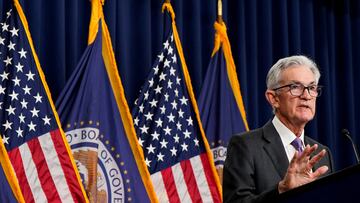FINANCE
“Rate cuts aren’t imminent,” reports Federal Reserve Chair Jerome Powell
For those hoping to see interest rates come down in the coming months, don’t hold your breath, Chair Powell says no cuts are “imminent”

Late last week, officials from the Federal Reserve made one thing clear: interest rates are not coming down any time soon.
Federal Reserve Chair Jerome Powell said in a speech last Friday at an event hosted by the Federal Reserve Bank of San Fransisco that the Federal Open Market Committee, the group tasked with determining the federal funds rate (FFR), does not feel any temporal pressure to reduce rates rapidly. The central bank has a dual mandate of keeping inflation under two percent and creating the conditions for full employment. Last week, the Bureau of Economic Analysis reported a 0.8 percent increase in the Personal Consumption Expenditure (PCE) from January to February. The PCE is the indicator used by the Fed to track inflation. With the annualized rate of inflation captured by the PCE’s most recent report showing prices rising above the two percent threshold, various FOMC members believe that the current monetary policy must be kept in place to prevent backsliding.
Fed Governor Christopher J. Waller echoed Chair Powell’s view last week, saying that the FOMC, believes “it is prudent to hold this rate at its current restrictive stance perhaps for longer than previously thought to help keep inflation on a sustainable trajectory towards 2 percent.”
The housing market and inflation
However, not all economists agree that continuing to hold interest rates at their current level will reduce inflation in the long run without damaging the economic well-being of workers and households. Nobel prize winner Joseph Stiglitz has argued that inflation seen in 2021 and 2022 was transitory and that the Fed’s reaction has made matters worse because it has increased prices in the housing market and had little effect on fixing supply chain issues that were fueling inflation that were brought on by the COVID-19 pandemic.
For Stiglitz, these supply chain issues were resolved as rates were hiked, leading prices in the durable goods market to soften. Next week, the Bueau of Labor Statistics will release the March Consumer Price Index report. In February, the CPI had tracked an increase in average prices of 0.4 percent —half that seen in the PCE for the same period. The BLS found that shelter and gasoline prices drove the CPI up, and these markets are not as directly influenced by monetary policy as other goods and services.
For instance, higher rates mean that the cost of borrowing increases, which leads businesses to forgo taking out loans to expand their businesses. The cost could end up being higher than the possible gain seen by the investment which does not make the taking on the loan a worthy investment.
In the housing sector, the dynamics are a bit more complicated. As interest rates for mortgages settle at levels not seen in decades, many potential homebuyers are holding onto their properties over concerns that they may not be able to find a better home and they would be saddled with a more expensive mortgage than the one they may currently be paying. The unwillingness of sellers to put their homes on the market decreases supply, thus increasing demand for houses that are for sale and boosting their prices. However, as prices rise, they will eventually hit a level where the buyers still in the market cannot afford the prices being offered and will exit, decreasing demand and thus bringing prices down. Home prices peaked in early 2023, when the median price of a home sold in the US was $479,500, whereas that figure now sits at $417,700. The supply of homes has dropped over the last year, and now remains slightly below the level seen one year ago.






